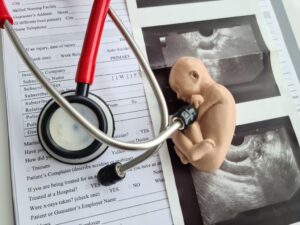Michigan Medical Malpractice and Birth Injury Case Arising From Cord Compression
A common cause of birth injuries is compression of the umbilical cord during labor. Although healthcare providers do not cause compression, they should usually be able to recognize when cord compression results in the baby not getting enough oxygen. If the obstetrician, midwife, or nurse recognizes potential cord compression, usually by noticing changes in fetal heart monitoring strips, interventions can be done to relieve the compression or deliver the baby. When cord compression goes undetected, and the baby suffers injury as a result, you may be able to sue for medical malpractice.
The birth injury lawyers at Hoffer & Sheremet have successfully and routinely handled cord compression cases. To see if we can help your baby and family, call us today.
What is Umbilical Cord Compression Malpractice?

Medical malpractice occurs when a healthcare provider such as a doctor, nurse, or midwife does not act as a reasonable healthcare provider would under the same or similar circumstances, which is called a breach of the standard of care, and the breach results in injury. When medical malpractice happens during child birth, we call the resulting injury a "birth injury" and refer to the medical malpractice case as a "birth injury case" or "birth injury litigation." If the baby dies, we might also refer to the case as one for "wrongful death."
What Causes Umbilical Cord Compression?
There are two main causes of umbilical cord compression during labor and delivery. Sometimes, the umbilical cord comes through the cervix and uterus before the baby. This is called "umbilical prolapse." The baby could compress the cord as he or she also descends through the birth canal. Sometimes, the cord is compressed by knots in the cord or compression by the baby.
How Does Umbilical Cord Compression Cause a Brain Injury in a Baby?

The umbilical cord is part of the vital link between mom and baby before birth. The umbilical cord carries blood between the baby and the placenta, where the blood receives oxygen and carbon dioxide is removed.
When the cord is compressed, less blood can flow through. This means that less oxygen reaches the baby and less carbon dioxide is removed. The delicate acid balance is disrupted. Not enough oxygen is available to the baby's organs, including the brain. The human brain requires a lot of oxygen to function. Low levels of oxygen, called hypoxia, can result in parts of the brain not receiving enough oxygen to function and for the cells to stay alive. The dying off of those cells is the cause of brain injury.
When is an Umbilical Cord Compression Injury Medical Negligence?
Even though doctors, nurses, and midwives don't cause cord compression directly, the standard of care requires them to be on the look out for any signs that a baby might be having trouble before it is born.
There are risk factors associated with cord compression that healthcare providers must be aware of. These include:
- Low amniotic fluid levels (which can be caused by premature rupture of membranes)
- Long cord
- Twin and triplet deliveries
- Malpositioned baby (breech delivery)
A tell-tale sign of cord compression that results in hypoxia is a change in fetal heart rate pattern. The fetal heart rate pattern is our way to peek into the uterus to see how baby is doing.
A healthy baby that is doing well during labor has a heart rate that changes - sometimes the baby will be sleeping, which results in a lower heart rate, and sometimes will be moving around, which results in a higher heart rate. This is called "variability." Happy babies have moderate variability in their heart rate, no decelerations (big drops in heart rate), and accelerations (increases in heart rate). The American College of Obstetrics and Gynecology refers to this as a "Category I" pattern.
A baby in a hypoxic, acidotic environment usually does not have a Category I pattern. Instead, we might see bradycardia (low heart rate), tachycardia (high heart rate), no accelerations, decelerations, and either minimal variability or marked variability (a heart rate that fluctuates between being too high and too low).
The job of the doctor, nurse, midwife and other healthcare providers is to pay attention to risk factors and how the baby is being affected. If the baby is showing signs that he or she is not doing well, the healthcare providers must react in some way. Sometimes, this is as simple as changing mom's position or performing an amnioinfusion (adding more fluid to the uterus), both of which can relieve compression and improve oxygenation. Other times, the baby needs to be delivered via C-section instead to continuing with vaginal delivery.
The failure to intervene or an unreasonable delay in C-section can be medical malpractice.
How Much is an Umbilical Cord Compression Birth Injury Settlement?

Every case is different. We have settled birth injury cases for millions of dollars and for hundreds of thousands of dollars. There are numerous factors that are considered. As we approach the time to settle your case, we will talk with you about a reasonable settlement value for your child's particular case.
The most important factors in determining a reasonable settlement amount are (i) the severity of the injury, (ii) future care needs and future medical equipment, (iii) home modifications, (iv) how bad the negligence was and (v) how directly the injury was caused by the malpractice.
The money you need to compensate for the injury is called "damages." Damages are divided into "economic" and "non-economic" damages. Economic damages include anything that costs money - future care costs, loss of income, mileage reimbursement, home care, medical equipment, etc. Non-economic damages are what people commonly call "pain and suffering," but they encompass all damages that don't cost money. Unfortunately, part of Michigan tort reform in the 1990s was to limit recovery of non-economic damages. It isn't fair, and it doesn't actually accomplish its intended purpose of keeping health care costs down (which, 30 years later, is obvious). We again encourage you to reach out to your representatives and senators to address this grave injustice. But in the meantime, there is a "low cap" and a "high cap." The cap is adjusted annually for inflation. The high cap is reserved for cases that result in quadriplegia, brain injury that results in the inability to make life decisions, or injuries that result in an inability to procreate. Shockingly, many cases that result in death do not qualify for the high cap.
The maximum amount your child can recover is called a "blackboard" number and helps guide the settlement amount. The higher the blackboard number and the stronger the case is on negligence and causation, the higher the settlement will be.
How Does a Lawsuit for a Birth Injury Work in Michigan?
If your child was severely injured by a cord compression that was negligently handled, you may be wondering, "How does a medical malpractice case work in Michigan?" We have put together a very detailed guide to Birth Injury Lawsuits in Michigan. But here is a brief overview of what you can expect in a Michigan medical malpractice lawsuit for a birth injury:
- Free initial case review: Every case starts with a free case review. You can complete our online form, email us, or call. We need a summary of what happened. We have been birth injury lawyers in Michigan for a long time, so sometimes we know right away if we will not be able to help you. If we think we might be able to help you, we will start investigating your case.
- Investigation: Our investigation starts by obtaining your and your baby's complete medical record. This includes prenatal records, hospital records, and any records of aftercare. Once we have reviewed the records, if we think there may be a case, we will send the records for review by an expert. If the expert is supportive, we will commence the lawsuit by sending a Notice of Intent or trying to settle the case pre-suit.
- Notice of Intent: Many states have enacted certain pre-suit requirements, including Michigan. In Michigan medical malpractice cases, we must send a "Notice of Intent" to every health care provider and facility that we intend to sue. This is nothing more than a summary of the basis of the lawsuit. Unfortunately, we must then wait 182 days until we actually file suit. (If you think this requirement is ridiculous, like we do, we encourage you to contact your local government representative.)
- Pre-suit Settlement: Based on our experience, we can generally identify cases that can be settled without filing a lawsuit. If we think your case is one of those, we will work directly with the hospital or insurance company to try to resolve your case without litigation.
- The Lawsuit: Litigation is a slow process. We file the medical malpractice complaint, then the defendants have time to file an answer. Those are called "pleadings." Next, we generally exchange written discovery, which is where we send questions back and forth and exchange documents. After that, months are spent in depositions. You and close family members are usually deposed first, then the defendants, than other fact witnesses, and then experts. "Motions," which is a fancy name for something filed with the court to ask the judge for a ruling, are filed both during and after discovery. A case can be settled any time, but the most common time is after depositions are done.
- Settlement or Trial: Most cases settle. This is particularly true with Hoffer & Sheremet because we vet our cases well. However, if a case cannot be settled for a reasonable amount, then we go to trial.
- Appeal: It will seem like trial should be the end of a case. But it's not. After trial, the losing side can appeal the verdict and any decision that the judge made in the case that could have affected the outcome. Appeals take years. And depending on the ruling, the appellate court may require that a new trial occur (after which there can be another appeal).
Contact Our Birth Injury Attorneys for a Free Case Review.

If your child suffered an injury during childbirth, such as hypoxic ischemic encephalopathy or other brain injury, and are now dealing with complications related to that injury such as cerebral palsy, it is important to explore your and your child's legal rights and see if you or your child have a medical malpractice claim. Birth injury litigation can be complex; our birth injury attorneys have a network of other professionals, from medical experts to financial experts. Our Michigan medical malpractice lawyers can help. Please contact Hoffer & Sheremet, PLC at (616)-219-2861 to learn more about compensation to which you may be entitled, email us, or complete our consultation request form.